Hey guys! I didn't have time to write because I was busy working on my Jeep 
Today way the TJ-day. I bought a sub box with integrated amp yesterday and finaly found time today to put it in. It took cca. 6 hours of work. I tried to do it as tidy as possible. Lost my nerves near the end but it all came out fine.
I also finally found time to investigate the rattles and found that both front sway bar links have a lot of play, like half an inch vertically. It was probably hard to see when the Jeep was on a lift at mechanic's.
I am sorry for posting dropbox links as it wont be online for long, perhaps a month or two. Also sorry for shaking the phone, its hard to record and sway the jeep
https://www.dropbox.com/s/xtkqam7e2kiqmmq/20180422_131719.mp4?dl=0
Is this the right part to order? Do I need anything else?
http://rover.ebay.com/rover/1/711-5...0001&campid=5337789113&icep_item=232394669503
When I was done with that I decided to shake everything I can grab and search for sounds and found a rattle in the steering column, where the axle enters the power steering hub. There is no rotational play, only vertical and horizontal, so I was thinking of maybe tightening the screw on top, it is visible in the video. Would that help, or I should replace some bushing or something?
https://www.dropbox.com/s/atnu4anur7d99kg/20180422_133054.mp4?dl=0
Unfortunately the focus was off when I recorded the exact point where the sound was coming from.
Now for the sub install...
I wanted to make the cabling as invisible as possible and not make any permanent damage. First things first, I found an entry point for the +12 V supply from the battery. There is a large rubber cap in the middle of the cabin below the console:
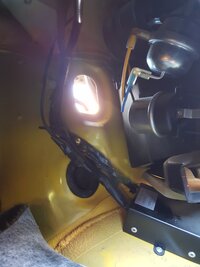
I pulled the rubber plug out and carefully cut a hole for the cable to come through. Piece of advice: Put a drop of dish washing detergent on the hole, the cable will slide through a lot easier.
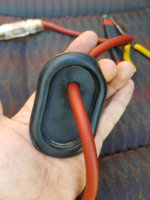
Then I put the cap back, without connecting the cable to the battery.
Next came hiding the cable below carpet and routing it to the back. Take your time on this as it is important to not pinch the cable or route it in a way passengers would be stepping on it. I got 3 shorter cables with the sub so I had to connect them. As I didn't have my soldering iron on me I went to a hardware store and bought this:
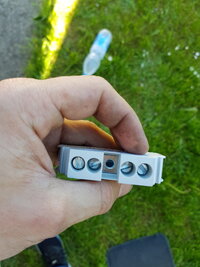
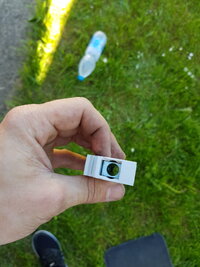
It was perfect for connecting 25mm2 cable to 15mm2 cable as the pieces I had didn't have the same thickness. In some point in future I will solder them together and put heat shrink tubing on the joint to make it waterproof.
It came out fine
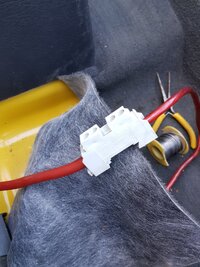
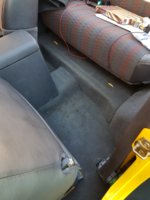
Next was the ground wire. I had a hard time choosing the screw I would use and broke one torx tool trying to unscrew different ones.
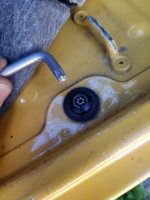
In the end I went for one of the screws holding the rear seat and it proved to be fine.
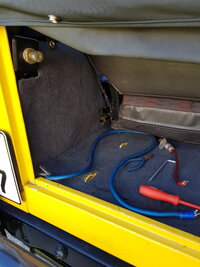
Thats about the point when I started losing my nerves.
Then came the choice of signal supply. Since my sub amp has a speaker level input I chose to route cable from front right speaker to the amp (speaker was also dead, I removed it and I am also planning to upgrade it as well as other speakers in the jeep)
Heres a few pictures of that:
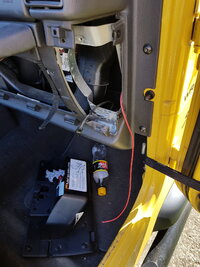
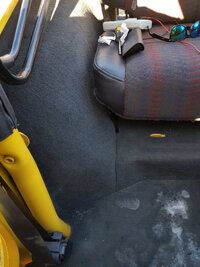
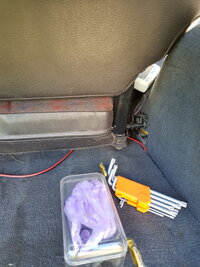
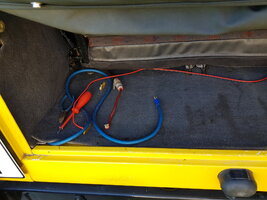
I so wish I knew I could fold the rear seat forward in 10 seconds, it would have saved me at least half an hour.
Interestingly, I used pins extracted from ATX power supply (standard PC power supply), squished them and put them inside original connector so I didn't have to cut it off. When I install a new speaker I will solder the pins directly to the speaker and connect the speaker this way.
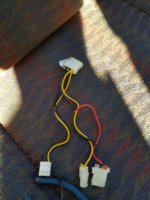
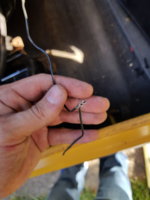
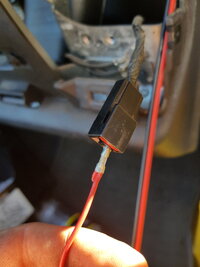
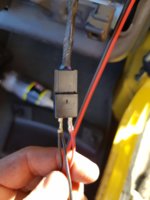
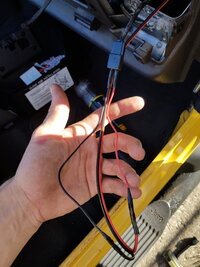
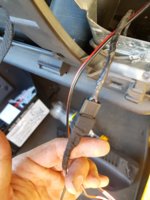
The pins fit tight and I insulated them with some electrical and fabric tape. It seems fine this way.
Here is everything connected. I used a lot of zip ties in the process and a lot of creativity
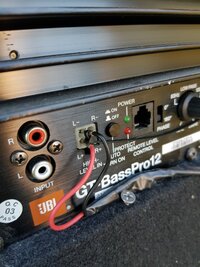
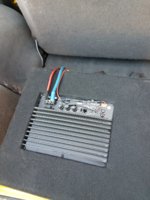
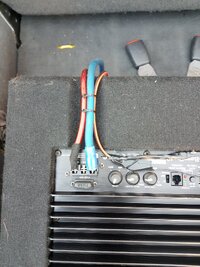
I forgot to connect the + and remote turn on as can be seen on the pictures but I fixed it later. Amp has the auto shutoff and activates when it senses signal on the speaker input. Great engineering JBL!
And only pic of the sub I have is from my instagram story, I hope you dont mind
https://www.dropbox.com/s/37o1r824g6ngfxl/Screenshot_20180423-010513_Instagram.jpg?dl=0
It fits perfectly with no space to waste, has around 1'' clearance to the trunk door. Only had to remove the steel protective bars sub came with. Now it vastly overpowers the sound bar speakers so they will have to be upgraded soon. If you think 150W RMS is not enough, rethink. It is almost impossible to drive when its on 50% power (perceptive 50%). You just cant hear the engine. On the max power it shakes my ass And thats coming from a guy that once popped his windshield with 2x12'' setup.
And thats coming from a guy that once popped his windshield with 2x12'' setup.
BTW I also used ATX power supply connectors to connect the speaker line to the amp (also a great fit and used zip ties to separate them).
Have a nice day, I hope I helped somebody!
Heres the link for the sub:
https://www.amazon.com/dp/B007GYU30K/?tag=wranglerorg-20
Today way the TJ-day. I bought a sub box with integrated amp yesterday and finaly found time today to put it in. It took cca. 6 hours of work. I tried to do it as tidy as possible. Lost my nerves near the end but it all came out fine.
I also finally found time to investigate the rattles and found that both front sway bar links have a lot of play, like half an inch vertically. It was probably hard to see when the Jeep was on a lift at mechanic's.
I am sorry for posting dropbox links as it wont be online for long, perhaps a month or two. Also sorry for shaking the phone, its hard to record and sway the jeep
https://www.dropbox.com/s/xtkqam7e2kiqmmq/20180422_131719.mp4?dl=0
Is this the right part to order? Do I need anything else?
http://rover.ebay.com/rover/1/711-5...0001&campid=5337789113&icep_item=232394669503
When I was done with that I decided to shake everything I can grab and search for sounds and found a rattle in the steering column, where the axle enters the power steering hub. There is no rotational play, only vertical and horizontal, so I was thinking of maybe tightening the screw on top, it is visible in the video. Would that help, or I should replace some bushing or something?
https://www.dropbox.com/s/atnu4anur7d99kg/20180422_133054.mp4?dl=0
Unfortunately the focus was off when I recorded the exact point where the sound was coming from.
Now for the sub install...
I wanted to make the cabling as invisible as possible and not make any permanent damage. First things first, I found an entry point for the +12 V supply from the battery. There is a large rubber cap in the middle of the cabin below the console:

I pulled the rubber plug out and carefully cut a hole for the cable to come through. Piece of advice: Put a drop of dish washing detergent on the hole, the cable will slide through a lot easier.

Then I put the cap back, without connecting the cable to the battery.
Next came hiding the cable below carpet and routing it to the back. Take your time on this as it is important to not pinch the cable or route it in a way passengers would be stepping on it. I got 3 shorter cables with the sub so I had to connect them. As I didn't have my soldering iron on me I went to a hardware store and bought this:


It was perfect for connecting 25mm2 cable to 15mm2 cable as the pieces I had didn't have the same thickness. In some point in future I will solder them together and put heat shrink tubing on the joint to make it waterproof.
It came out fine


Next was the ground wire. I had a hard time choosing the screw I would use and broke one torx tool trying to unscrew different ones.

In the end I went for one of the screws holding the rear seat and it proved to be fine.

Thats about the point when I started losing my nerves.
Then came the choice of signal supply. Since my sub amp has a speaker level input I chose to route cable from front right speaker to the amp (speaker was also dead, I removed it and I am also planning to upgrade it as well as other speakers in the jeep)
Heres a few pictures of that:




I so wish I knew I could fold the rear seat forward in 10 seconds, it would have saved me at least half an hour.
Interestingly, I used pins extracted from ATX power supply (standard PC power supply), squished them and put them inside original connector so I didn't have to cut it off. When I install a new speaker I will solder the pins directly to the speaker and connect the speaker this way.






The pins fit tight and I insulated them with some electrical and fabric tape. It seems fine this way.
Here is everything connected. I used a lot of zip ties in the process and a lot of creativity



I forgot to connect the + and remote turn on as can be seen on the pictures but I fixed it later. Amp has the auto shutoff and activates when it senses signal on the speaker input. Great engineering JBL!
And only pic of the sub I have is from my instagram story, I hope you dont mind
https://www.dropbox.com/s/37o1r824g6ngfxl/Screenshot_20180423-010513_Instagram.jpg?dl=0
It fits perfectly with no space to waste, has around 1'' clearance to the trunk door. Only had to remove the steel protective bars sub came with. Now it vastly overpowers the sound bar speakers so they will have to be upgraded soon. If you think 150W RMS is not enough, rethink. It is almost impossible to drive when its on 50% power (perceptive 50%). You just cant hear the engine. On the max power it shakes my ass
BTW I also used ATX power supply connectors to connect the speaker line to the amp (also a great fit and used zip ties to separate them).
Have a nice day, I hope I helped somebody!
Heres the link for the sub:
https://www.amazon.com/dp/B007GYU30K/?tag=wranglerorg-20
Last edited:
This site contains affiliate links for which Jeep Wrangler TJ Forum may be compensated.

